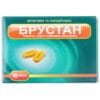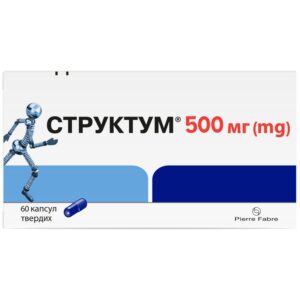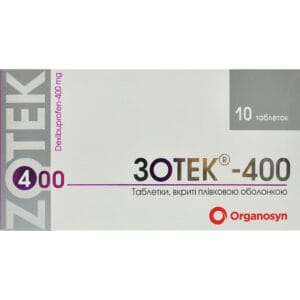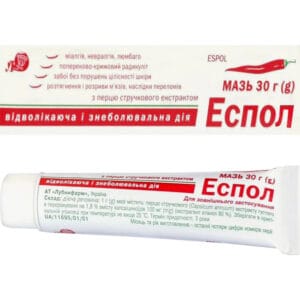We are temporarily not accepting orders from Canada due to the Canada Post strike.
Nous n’acceptons temporairement pas de commandes en provenance du Canada en raison de la grève de Canada Post.
We are temporarily not accepting orders from Canada due to the Canada Post strike.
Nous n’acceptons temporairement pas de commandes en provenance du Canada en raison de la grève de Canada Post.

Algozan gel tube 35 g
$17.42
ALGOZAN gel relieves pain, inflammation, and swelling in joints, muscles, and veins. Contains diclofenac and horse chestnut extract for topical use.
Instruction
For medical use of the medicinal product
Algozan
Composition:
Active ingredients: diclofenac diethylamine, chestnut seed dry extract;
1 g of gel contains diclofenac diethylamine in terms of 100% substance – 15 mg, dry chestnut seed extract (Hippocastani semen extractum siccum) (5-7: 1), (extractant – 60% ethanol, excipient – maltodextrin) – 100 mg, in terms of escin – 5 mg;
Excipients: methyl parahydroxybenzoate (E 218), propyl parahydroxybenzoate (E 216), ethanol 96%, propylene glycol, carbomer, triethanolamine, purified water.
Dosage form.
Gel.
Main physicochemical properties: gel from light brown to yellow-brown in color, homogeneous consistency. Impurities are allowed.
Pharmacotherapeutic group.
Nonsteroidal anti-inflammatory drugs for topical use. diclofenac, combinations.
PBX code M02A A65.
Pharmacological properties.
Pharmacodynamics.
Algozan is a combined drug containing nonsteroidal anti-inflammatory drugs (NSAIDs) – diclofenac diethylamine and angioprotective agent – horse chestnut seed extract. The overall effect of these components in the drug leads to a decrease or elimination of pain and inflammation, helps to increase the range of motion in the affected joints and reduce morning stiffness, accelerates the disappearance of post-traumatic hematomas, edema, prevents blood stasis in venous insufficiency.
Diclofenac diethylamine. Blocks the synthesis of prostaglandins, eliminates or significantly reduces the severity of inflammation symptoms, reduces the increased sensitivity of nerve endings to mechanical and biologically active substances that are formed at the site of inflammation; penetrates well through the skin and accumulates in adjacent tissues, penetrates into the area of inflammation.
Horse chestnut seed extract dry. Escin. Escin is a natural mixture of triterpene saponins obtained from the seeds of horse chestnut (Aesculus hippocastanum L.), which have anti-edematous, venotonic properties and anti-inflammatory activity. In addition, escin acts at the initial stage of the inflammatory process, which is associated with increased membrane and capillary permeability and the production of exudate in adjacent tissues.
Escin has antiserotonin and antihistamine effects.
Escin inhibits the activity of prostaglandin synthetase. This enzyme is necessary for the formation of prostaglandins, which play an important role in the mechanism of inflammation.
Escin prevents the decrease in the content of adenosine triphosphate (ATP) in endothelial cells and increases the activity of phospholipase A 2, an enzyme responsible for the release of precursors of inflammatory mediators. Escin reduces the activity of lysosomal enzymes that break down proteoglycans contained in the capillary walls. This increases the resistance of capillaries, reduces their permeability, thus reducing the amount of exudate and the formation of edema.
Pharmacokinetics.
The amount of diclofenac absorbed through the skin is proportional to the area of application and depends on both the total dose of the drug applied and the degree of skin hydration. After topical application of 2.5 g of the drug to a skin surface area of 500 cm 2, the degree of absorption of diclofenac is approximately 6%. Diclofenac diethylamine binds to serum proteins by 99.7%, mainly to albumin (99.4%), penetrates into the synovial fluid (the half-life from the synovial fluid is 3-6 hours), penetrates the placenta and the blood-brain barrier, and is excreted in the urine.
Escin is well absorbed by tissues, its maximum concentration in blood plasma is reached after 2-3 hours, undergoes metabolism in the liver. It is excreted from the body mainly with bile in the form of metabolites, to a lesser extent – with urine. The half-life is up to 20 hours.
Clinical characteristics.
Indication.
Symptomatic treatment of pain, inflammation and swelling in:
- soft tissue injuries: injuries to tendons, ligaments, muscles and joints (due to dislocation, sprain, bruises); sports injuries;
- localized forms of soft tissue rheumatism: tendonitis (including “tennis elbow”), bursitis, shoulder syndrome and periarthropathy; localized forms of degenerative rheumatism (osteoarthritis of peripheral joints and spine).
Symptomatic therapy for diseases and symptoms caused by impaired peripheral circulation:
- varicose veins;
- leg swelling and pain associated with venous insufficiency;
- post-traumatic hematomas and hematomas after injections and infusions.
Contraindication.
Hypersensitivity to diclofenac or other components of the drug, renal failure, hematopoietic disorders; presence of erosive-ulcerative lesions of the gastrointestinal tract.
History of attacks of bronchial asthma, angioedema, urticaria or acute rhinitis caused by taking acetylsalicylic acid or other NSAIDs.
The drug is contraindicated during pregnancy or breastfeeding.
Interaction with other drugs and other types of interactions.
When using the gel, other medications should not be applied to the same area of skin at the same time.
Diclofenac, contained in the drug, potentiates the specific effects of oral NSAIDs when used simultaneously, as well as ulcerogenic corticosteroids; increases the concentration of digoxin and lithium in the blood; weakens the effect of diuretics and saluretics of the thiazide and furosemide groups.
The therapeutic efficacy of the gel with salicylates is reduced, while the ulcerogenic effect on the gastric mucosa is enhanced.
When used simultaneously with coagulants and anticoagulants, the state of the blood coagulation system should be monitored.
Since Algozan contains escin as part of the horse chestnut seed dry extract, it is not used in combination with drugs that inhibit ovulation.
Application features.
You should consult a doctor before use.
Do not use a dosage that exceeds the recommended one.
The gel should be applied only to intact skin, avoiding contact with inflamed, injured or infected skin. Avoid contact of the medicinal product with eyes and mucous membranes. The product should not be swallowed.
Do not rub when applying.
The possibility of systemic side effects (which occur with systemic forms of diclofenac) should be taken into account when applying the drug to larger areas of skin or for a longer period than recommended. In such cases, the drug should be used with caution in patients with hepatic, renal or cardiac insufficiency, a history of hematopoietic system diseases, as well as peptic ulcer disease in the active stage, while using other NSAIDs.
In case of sudden onset of severe symptoms of venous insufficiency (sudden swelling of one or both legs, change in skin color, feeling of tension and severe pain), especially in one limb, thrombosis of the veins of the lower extremities should be excluded.
The drug should not be used under an airtight occlusive dressing.
In case of a sprain, the affected area can be bandaged.
The product contains methyl parahydroxybenzoate (E 218) and propyl parahydroxybenzoate (E 216), which may cause allergic reactions, including bronchospasm. The product contains propylene glycol, which may cause mild localized skin irritation.
If any skin rash appears, treatment with the drug should be discontinued.
Due to the possibility of photosensitivity, direct sunlight and visits to the solarium should be avoided during treatment and for 2 weeks after discontinuation of treatment.
Use during pregnancy or breastfeeding.
The drug should not be prescribed during pregnancy or breastfeeding.
The ability to influence the reaction speed when driving vehicles or other mechanisms.
Does not affect.
Method of administration and doses.
Gel for external use.
Daily dose: 2 g of gel is applied in a thin strip (about 10 cm) to the skin at the site of inflammation (joints, veins and other parts of the body with inflammation and pain, avoiding contact with damaged skin surfaces, open wounds, mucous membranes) 2-4 times a day. After applying the gel, an occlusive dressing should not be applied.
The average daily dose is 4-8 g of gel.
The course of treatment is 14 days. The duration of treatment depends on the severity and course of the disease and is determined by the doctor.
It is necessary to consult a doctor if the patient’s condition has not improved or worsened after 7 days of treatment.
Children.
Not used in pediatric practice.
Overdose.
Overdose is unlikely.
In case of overdose, the following are possible: allergic reactions (itching of the skin, rash, burning sensation), the occurrence of systemic side effects characteristic of diclofenac (generalized skin rashes, angioedema, photosensitivity, headache, drowsiness, dizziness, nausea, gastrointestinal disorders).
Treatment: stop taking the drug, if an excessive amount of the drug is used, rinse the skin with plenty of cool water, consult a doctor. Symptomatic therapy.
In case of accidental ingestion of the drug, the stomach should be emptied immediately and an adsorbent should be taken, and a doctor should be consulted. Symptomatic treatment is recommended using therapeutic measures that are used to treat poisoning with nonsteroidal anti-inflammatory drugs. Symptomatic therapy.
Adverse reactions.
Mild transient skin reactions are possible at the application sites.
In rare cases, allergic reactions occur.
Infections and infestations: Pustular rash.
Immune system disorders: hypersensitivity reactions, angioedema.
From the respiratory system: bronchial asthma.
Skin and Appendages: rash, erythema, eczema, dermatitis; bullous dermatitis; photosensitivity reactions, itching, rash, burning sensation.
If these symptoms occur, you should stop treatment and consult a doctor.
Expiration date.
2 years.
Do not use the drug after the expiration date indicated on the package.
Storage conditions.
Store at a temperature not exceeding 25 °C.
Keep out of reach of children.
You may also like








Reviews
There are no reviews yet.